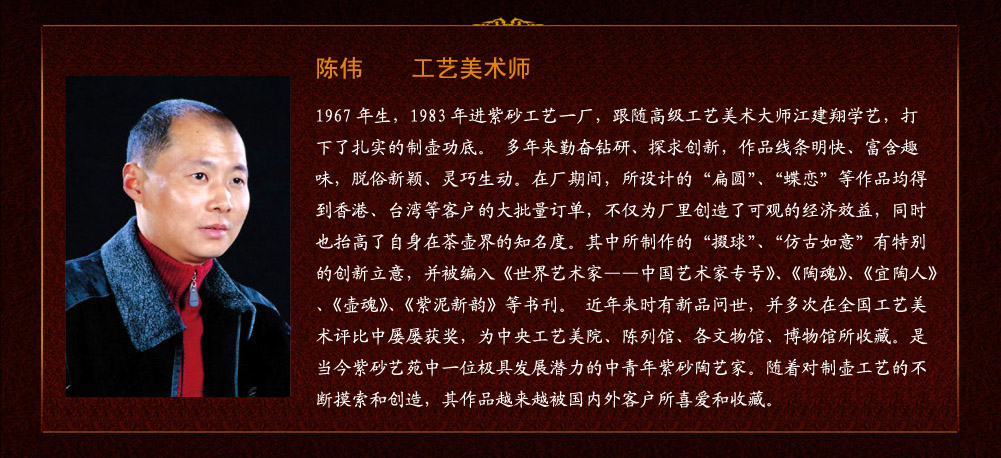Xu Sihai (许四海), not a native of Yixing, is a retired army personnel who loved the Yixing art and culture so much that he left the army and pursued a career in Yixing at the age of 40. He called himself
'the outsider' and went to Yixing to work and learn the art of teapot making. He made friend with a famous painter,Tang Yun, and made teapots designed by him. He managed to gain some fame in Yixing amidst the large pool of already well known potters at a that time.
In the 1980s, Singapore Chinese Tea House, a local company engaged in tea drinking business, commissioned Xu to make some teapots bearing Chinese Tea House logo to commemorate the operation of tea drinking business of the company in Singapore. Xu engaged a potter from Yixing and made the teapots (around 180 to 200 pieces) for delivery to Singapore Tea House. The teapots bear
Singapore Tea House logo at the bottom, the potter's name at the inside of the cover and
Supervised by Xu Sihai at the bottom of the handle. These teapots have a globular shape which is very appealing esthetically and the pots season very well. They are very good for brewing fine kungfu tea due to their small size. After years of using them for brewing tea, they will develop a glossy appearance outside.
 |
| Xu Sihai's commissioned teapots |
Alans Museum has 2 such teapots acquired in the early 1990s. They are made from black and red Yixing zisha clay.
许四海: 字紫云,1946年生,盐城人。师从国画大师唐云,作品“夏意”获国家金牌奖。与多位书画名家合作的“海春壶”“寿翁壶”“啸天壶”和“云海壶”堪称一绝,并为“八运会”“香港回归”“上海国际茶文化节”等特制专用茶壶。1989年新加坡成功举办个人作品展,号称江南壶怪。许四海是一位在海内外享有盛誉的紫砂陶艺大家,也是一位极富传奇色彩的鉴藏家。
一套向2010年上海世博会献礼的紫砂“世博汉字壶”于2010年2月18日在沪面世,传承中华数千年历史的汉字与中国传统手工紫砂工艺珠联璧合而成为精品茗具。中国世博纪念品研发工作室与素有“江南壶怪”
许四海生于1946年5月15号
1959-1960
上海第四建筑工程公司 水泥工木工
1964.9-1967.7 参军,任
广州空军
惠阳场站通讯连班长
1969.9-1971 回国任惠阳场站警卫连指导员
1971-1980 广州空军第三十五师文化干事
1984-1987应聘到江苏宜兴紫砂二厂担任助理厂长
1985年
中国轻工部举办首届全国陶瓷作品评比中许四海作品紫砂滴水“夏意”获得了最高分夺得金奖,后来这件作品又被美国亚洲艺术博物馆收藏
1989年 应邀赴新加坡举办个人陶艺作品展览
1987-1992 回上海创办四海茶具馆 四海茶文化发展有限公司 四海陶瓷发展有限公司 创立四海窑紫砂茶具品牌
2009年完成百佛园建设及四海艺术馆建设为迎上海世博会2010年正式对外开放
 |
| Xu Xihai, 许四海 |

















































